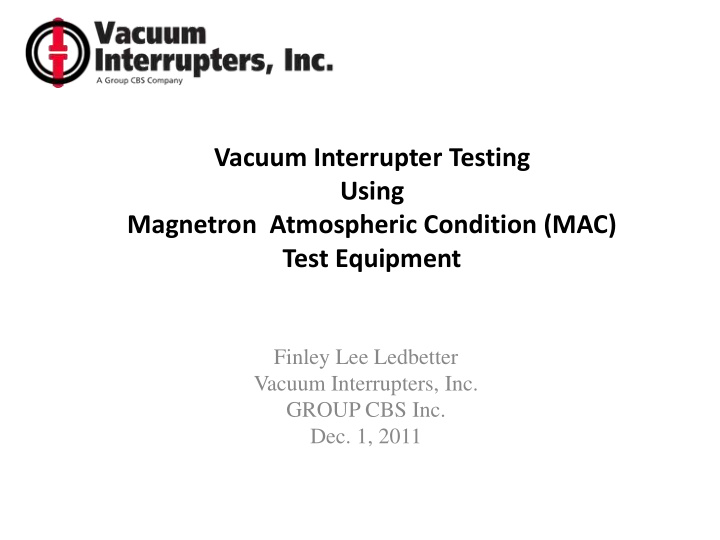



Vacuum Interrupter Testing Using Magnetron Atmospheric Condition (MAC) Test Equipment Finley Lee Ledbetter Vacuum Interrupters, Inc. GROUP CBS Inc. Dec. 1, 2011
Reasons for Testing with MAC Test Equipment History • The majority of vacuum interrupters were installed in the 1980 ’s and given an original life expectancy of 20 years. • Vacuum interrupters installed in this period have far exceeded their m anufacturer specified life expectancy. • Failure of a vacuum interrupter could result in unnecessary downtime and damage to surrounding equipment. Traditional testing methods • Vacuum integrity Pass or Fail test using high voltage ac test set. • Not capable of determining level of vacuum inside interrupter. • Not capable of determining the life expectancy of vacuum interrupters 2
MAC Testing Overview • Until recently, lubricating and preventative maintenance were the only means of preserving breaker life. • The current accepted field service test for vacuum interrupters is a simple Go/No- Go AC Potential Test. • Vacuum interrupters can catastrophically fail at any time taking many days to clean, repair, and get the switchgear back online. • MAC testing can prevent unnecessary damage to breaker by predicting usable life of vacuum interrupter. • This testing has only been available in the assembly plant until now. • With new flexible magnetic field coils, vacuum interrupters can be tested in place. • By taking all parameters into consideration, trend to failure can be predicted. 11
MAC Testing Technology • MAC vacuum interrupter testers use the Penning dicharge principle to determine the level of vacuum inside a vacuum interrupter • The test results obtained are compared to an "ionization current - pressure curve" that we have determined in our lab for that particular type of vacuum interrupter using a vacuum test system • T he t est results are compared to the lab generated curve • Using this data together with other parameters, trend to failure can be predicted using condition based predictive maintenance 10
Conditioned Based Predictive Maintenance • Breaker type and serial number • Breaker date of manufacture • Breaker condition and atmosphere • Breaker operating conditions • Number of operations • Known vacuum interrupter batch or type strengths or decencies • Vacuum interrupter part number and serial number • Vacuum interrupter wear indication • Vacuum interrupter contact resistance • MAC test data • MAC database trend information. • Circuit criticality 10
Typical Vacuum Interrupter 4
Penning Discharge Principle • Charged particles (ions) can be generated from high voltage supplied across an open vacuum interrupter. When a strong magnetic field is applied, these ions will move, thereby, producing a current across the open contacts. This ionization current is directly proportional to the pressure inside the vacuum interrupter. With a known pressure-ionization current curve, the pressure inside a vacuum interrupter can be easily determined through the Penning Discharge principle. Current meter Magnetic Field coil HV Power Supply __________________________ 3 J. Eichmeier, Moderne Vakuumelektronik. Berlin, Germany: Springer- Verlag, 1981, pp. 243 – 273
Vacuum Test System In order to create the ‘ionization current - pressure curve’ for the MAC-TS1 and MAC-TS2 Testers, 40 data points are required for each unique vacuum interrupter within the range 1x 10 -1 Pa -1x10 -5 Pa. 9
MAC-TS1 Test Set - Lab/Shop Use Technical features Button board Display unit • Light weight unit for lab/shop use • Measurement range: 1 x 10 -5 Pa ~ 1 x 10 -1 Pa Control measuring unit • Measurement accuracy: <10 % in 1 x 10 -4 ~ 1 x 10 -1 • Uses Fixed Magnetic Field Coil or Flexible Magnetic Rope Magnetic current • Easy and safe to operate High voltage unit control unit 5
Magnetic Field Coil A lab-based magnetic field coil for testing individual vacuum interrupters that have been removed from a breaker or contactor. The coil allows for a consistent, uniform magnetic field and accurate vacuum interrupter condition measurement. The magnetic coils are used in conjunction with the MAC-TS1 tester. The magnetic field coil comes in various sizes to accommodate most vacuum interrupters. 6
MAC-TS2 Test Set - Field / Shop Use Button board Display unit Technical features • Light weight, portable test set for field or shop use • Measurement range: 1 x 10 -5 Pa ~ 1 x 10 -1 Pa Control measuring unit • Measurement accuracy: <10 % in 1 x 10 -4 ~ 1 x 10 -1 • Easy and safe to operate Magnetic current • Operates only with flexible magnetic field coils. High voltage unit control unit 7
Flexible Magnetic Field Coils A flexible magnetic coil for testing vacuum interrupters while installed in a breaker or contactor, making it ideal for field use. The flexible magnetic field coils are used in conjunction with the MAC-TS1 or MAC-TS2 test sets. The flexible magnetic field coil comes in various lengths to accommodate most vacuum applications. 8
Summary • Vacuum interrupter testing utilizing MAC testers can provide a viable means of determing the condition of vacuum interrupters prior to failure • When used with the patent pending, flexible magnetic field coil, vacuum interrupters can be to be tested in-place while installed in your circuit breaker or contactor • Using condition based predictive maintenance inconjunction with MAC tester data, trend to failure of vacuum interrupters can be predicted 11
Recommend
More recommend